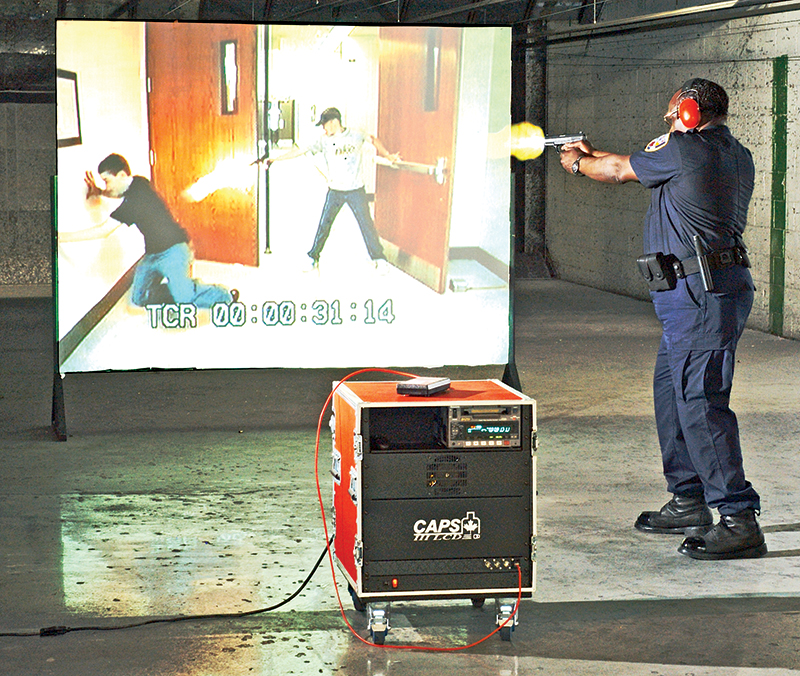
STRESS2_800
In my time I’ve seen controversies come and go. Most of them have been sorted out over the years, but I still see a number of longtime controversies refusing to die. These generally revolve around which techniques can be used during a stressful event. For example, the old target-focused shooting vs. sighted shooting controversy is still alive and well. Go to one school and they’ll tell you that you can’t see your sights under the stress of a violent encounter; go to another and they’ll insist using your sights to get accurate shots is the only way to prevail in such a situation.
The issue remains alive because it’s both complicated and situational, but there is an answer. The Science

Simulators, like the CAPS system shown here, allow cops to use live ammo and their real gun, adding significantly to the realism. It’s a great way to avoid SNS override in the field.
First we have to understand how stress affects us, and because this isn’t a science class, I’m simplifying things. The nervous system is divided into the Somatic Nervous System (SoNS) and Autonomic Nervous System (ANS). The SoNS controls our body’s voluntary movements through our muscular systems — we’re telling our bodies what to do. The ANS directs our involuntary functions like heartbeat and respiration without conscious thought.
The ANS is further divided into two basic branches: the Parasympathetic Nervous System (PSNS), which facilitates the conservation and restoration of energy, and the Sympathetic Nervous System (SNS), which prepares us for our fear response (think fight or flight). Sympathetic responses cause — among other things — tunnel vision, auditory exclusion and target focus.
The PSNS and the SNS are usually in balance with one another and within normal bounds so long as nothing unusual is happening to us. However, when we perceive danger, the SNS tends to dominate the PSNS, a condition often colloquially called Body Alarm Reaction, but I call it SNS dominance. At its mildest levels, SNS dominance occurs when we anticipate something stressful. Its most extreme manifestation occurs if we find ourselves startled by a spontaneous deadly threat. This extreme state of SNS dominance I call SNS override. In a state of SNS override, we can’t help but lose fine motor control — we look at the threat (not our sights), we crouch and we may not even be able to move (we may freeze in place).
Train For Control
Regardless of training level, the more stress we’re under, the greater the SNS dominance, and thus the less voluntary control we have over our physiological mechanisms and even muscle control. Training does not overcome the tendency towards SNS override as the level of stress increases — the most highly trained specialist in the world will target-focus, freeze in place and become incapable of anything but gross movements if placed under enough stress. What differentiates the trained person from the lesser trained person is the amount of stress they can be under and still maintain control over their actions.
To this end, the purpose of square range training is to increase our baseline skill level, while the purpose of stress-inducing training (through simulators or force-on-force scenario training) is to allow us to maintain voluntary control under increasing levels of stress and realism.
In any given situation, a realistically trained person might remain in acceptable control of their reactions, while a lesser trained person will default to the effects of body alarm. A well-trained person, placed in a dangerous situation — but one they’ve been through many times in training — may well be able to focus on their sights, keep their heart rate under control and be able to perform fine motions such as weapons manipulations. A lesser trained person, placed in the same situation, may well tip over into SNS override and lose control.
Note that one element of the amount of stress you’re under is how much perceived control you have over the situation, and this can be related to whether or not you initiated the event. For example, a SWAT officer making entry or an experienced cop making a felony stop may clearly remember seeing their sights if a shooting erupts. A rookie placed in the same situation might be expected to threat-focus. Now suppose on the SWAT entry, things suddenly go south: a bad guy suddenly pops out of a surprise location — the same SWAT officer might be expected to threat-focus.
So the next time someone voices an arrogant opinion about what can or can’t be done under stress, poke a little, using the facts above, to see if they really know what they’re talking about.














